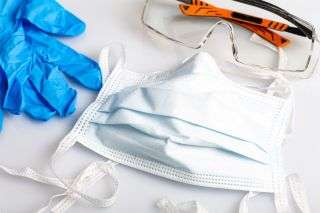
Social distancing, face masks and eye protection all appear to reduce the spread of COVID-19, in both health care settings and the general community, according to a new review commissioned by the World Health Organization (WHO).
The review found that keeping a distance of at least 3 feet (1 meter) from other people lowered the chances of coronavirus infection or spread by 82%, and keeping a distance of 6 feet (2 m) could be even more effective.
Wearing face masks and cloth face coverings was also linked with COVID-19 protection for the general public; the same was true for health care workers, but N95 masks provided greater protection in health care settings than other types of masks. Eye protection, which people perhaps tend to think about less than nose and mouth protection, may also provide additional benefits in both community and health care settings, the authors said.
However, the authors note that the findings on face masks and eye protection are based on limited evidence. And overall, none of the practices examined in the study fully protected against COVID-19.
“Although distancing, face masks and eye protection were each highly protective, none made individuals totally impervious from [COVID-19] infection,” study lead author Dr. Derek Chu, a clinician scientist in the Department of Health Research Methods, Evidence and Impact, and the Department of Medicine at McMaster University in Ontario, said in a statement. For this reason “basic measures such as hand hygiene are also essential to curtail the current COVID-19 pandemic and future waves,” he said.
For the new review, published yesterday (June 1) in the journal The Lancet, Chu and his team examined studies on COVID-19 as well as the related conditions SARS and MERS. Overall, the researchers analyzed information from 44 studies involving more than 25,000 people in 16 countries. (Seven of these studies involved COVID-19, 26 involved SARS and 11 involved MERS.)
The studies examined the effects of social distancing, face masks and eye protection (such as face shields, goggles and glasses) on virus transmission. (The researchers considered these measures separately rather than in combination. They were not able to examine how a person’s duration of potential exposure affected their risk of infection.)
With social distancing, the chances of infection or transmission of these coronaviruses was about 3% when people kept a distance of at least 3 feet from others, compared with 13% when people kept a distance of less than that. What’s more, for every extra 3 feet (up to 10 feet, or 3 m), the risk of infection or transmission of these coronaviruses was reduced by half.
With face masks, the chance of infection or transmission was 3% with a mask compared with 17% without a mask, a reduction of more than 80%. And for eye protection, the chance of infection or transmission was 6% with protection and 16% without.
“Our findings are the first to synthesize all direct information on COVID-19, SARS and MERS, and provide the currently best available evidence on the optimum use of these common and simple interventions to help ‘flatten the curve,'” study senior author Holger Schünemann, a professor at McMaster University, said in the statement.
Additional analysis in health care settings found that N95 respirators were 96% effective at protecting workers in these settings, while other types of masks (such as surgical masks) were 77% effective.
These findings show that “for health care workers on COVID-19 wards, a [N95] respirator should be the minimum standard of care,” Raina MacIntyre, a professor of global biosecurity at the University of New South Wales’ Kirby Institute in Australia, and colleagues, wrote in a commentary accompanying the study.
The review also “supports universal face mask use, because masks were equally effective in both health care and community settings,” the commentary said.
However, the review did not include any randomized control trials — the goal standard of medical research in which people are randomly assigned to a treatment or control group. (There were no randomized control trials on this topic.) Rather, the review looked at observational studies in which researchers observe populations without assigning a treatment. Randomized controlled trials now are needed, particularly those examining the effect of face masks on infection risk; and two such trials for masks are currently underway in Denmark and Canada, the authors said.
Sourse: www.livescience.com





